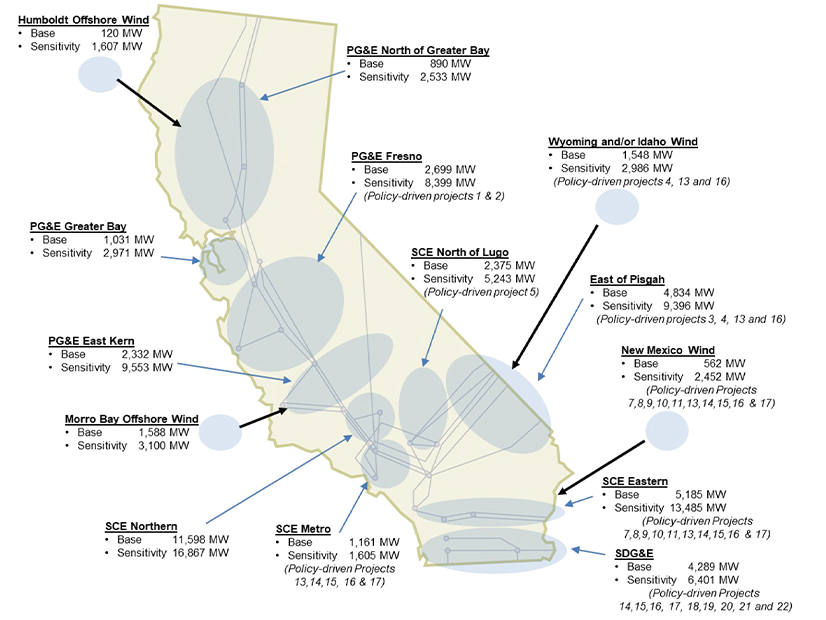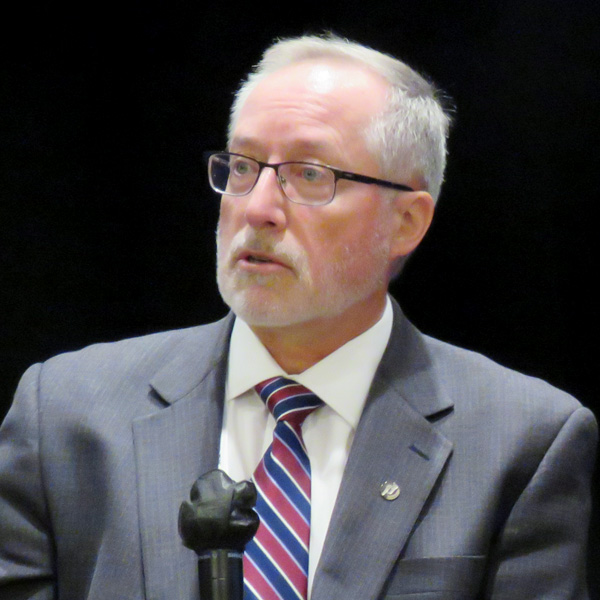
The CAISO Board of Governors on Thursday approved a $7.3 billion transmission plan that breaks with the ISO’s traditional planning process in an effort to bring needed resources online faster while dealing with an interconnection queue that has grown too large and unworkable.
“The plan reflects a more proactive and strategic approach in studying and recommending new transmission infrastructure needed to reliably and efficiently meet California’s clean energy objectives over the next decade and beyond,” Neil Millar, CAISO’s vice president of infrastructure and operations planning, told the board.
The new approach aligns with a memorandum of understanding that the leaders of CAISO, the California Public Utilities Commission and the California Energy Commission signed in December to establish closer links between their planning processes, Millar said. (See CAISO CEO Lauds Transmission Planning Agreement.)
 Neil Millar, CAISO | © RTO Insider LLC
Neil Millar, CAISO | © RTO Insider LLCIn California’s divided energy planning process, the CEC forecasts demand, the CPUC orders utilities to procure resources and CAISO handles transmission planning and interconnecting new resources to its grid.
“The MOU tightens the linkages between resource and transmission planning activities, interconnection processes and resource procurement,” Millar wrote in a briefing paper to the board.
Under the reworked process, CAISO is taking a new “zonal” approach to transmission planning that targets regions of the state where resources can be developed and interconnected to transmission most effectively, such as the southern Central Valley, where more large-scale solar arrays with battery storage are proposed.
“As set out in the MOU, expectations are that the CPUC will continue to provide resource planning information to the ISO as it did for this transmission planning cycle,” Millar wrote. “The ISO will develop a final transmission plan, initiate the transmission projects and communicate to the electricity industry specific geographic zones that are being targeted for transmission projects along with the capacity being made available in those zones.
“The CPUC will in turn provide clear direction to load-serving entities to focus their energy procurement in those key transmission zones, in alignment with the transmission plan. To bring this more coordinated approach full circle, the ISO will also give priority to interconnection requests located within those same zones in its generation interconnection process.”
Adding 7,000 MW a Year
The goal is to expedite the interconnection of new resources needed for the state’s transition to 100% clean energy while maintaining reliability.
“The need for additional generation of electricity over the next 10 years has escalated rapidly in California as it continues transitioning to the carbon-free electrical grid required by the state’s clean-energy policies,” Millar wrote. “This in turn has been driving a dramatically accelerated pace for new transmission development in current and future planning cycles — as much as 7,000 MW/year over the next decade.”
The 2022/23 transmission plan adopted Thursday calls for 45 projects totaling $7.3 billion that California needs over the next decade. They include 24 reliability projects “driven by load growth and evolving grid conditions as the generation fleet transitions to increased renewable generation” and 21 policy-driven projects totaling $5.53 billion to “meet the renewable generation requirements established in the CPUC-developed renewable generation portfolios,” he wrote.
The plan is based on the CPUC’s projections that the state needs to add at least 40 GW of new resources over the next 10 years in a base-case scenario and 70 GW by 2032 in a “sensitivity” scenario “reflecting the potential for increased electrification occurring in other sectors of the economy, most notably in transportation and the building industry,” the transmission plan says.
“The network upgrades are recommended in this plan to make all of the base amounts available and, in Southern California, to also make most of the sensitivity amounts available as well,” it says.
The final tally of projects differs from an April 3 draft because a 500-kV line project, estimated at $2 billion, “has been held back pending additional analysis of stakeholder input and may be considered as an extension to this planning cycle or the next planning cycle.” (See CAISO Retools Transmission Plan for Reliability, Renewables.)
In a letter to the board, the Northern California Power Agency, which invests in resources for 16 member cities and public entities, expressed concern over the plan’s projected costs.
“With $7.3 billion in estimated new investment, the Revised Draft 2022-2023 Transmission Plan will be the most expensive plan in CAISO’s history,” the agency wrote. “CAISO estimates the high voltage transmission access charge will increase from under $15/MWh today to over $22/MWh in a decade.”
“That estimate does not include the possibility of cost overruns (an inevitability), transmission investments made outside CAISO’s planning process (historically the bulk of transmission investment), or the impact to the low-voltage transmission access charge (which substantially exceeds high-voltage in certain TAC areas); thus, the true impact to California electric consumers will be much greater than the CAISO estimates alone,” NCPA wrote.
In Thursday’s meeting, Millar said CAISO takes the high costs seriously, and that the transmission plan is designed to meet the state’s needs in the most cost-effective way.
Some projects in the 2022/23 plan address needs outlined in the 70-GW sensitivity portfolio, which the CPUC expects to be the base case next year, he said.
“We need to get a head start on these major projects,” Millar said.
Next year’s transmission plan will address more sensitivity-case projects as well as transmission for offshore wind development and will also be expensive, he said.
But the two annual plans should address the “bulk of the major corridor requirements” for years, he said.
“This is not going to be year-over-year at this level of expenditure,” Millar said.
Interconnection Process Enhancements
The board on Thursday also approved the first phase of its interconnection process enhancements to help deal with an overwhelming number of generator interconnection requests.
CAISO received 359 interconnection requests totaling more than 105 GW during its Cluster 14 window in April 2021, quadruple the number from prior years, with 205 projects totaling 65.5 GW proceeding into phase 2 of the interconnection study process.
This year it received 541 requests totaling 354 GW for its Cluster 15 window.
Running cluster studies on such an immense volume of requests makes little sense, CAISO CEO Elliot Mainzer has said.
In March, the ISO launched a stakeholder initiative to revamp its interconnection process and fast-tracked it for approval by the Board of Governors.
The new initiative has two tracks. In the first track, CAISO proposed postponing its processing of Cluster 15 requests until the Cluster 14 studies are finished next year.
The board approved that track Thursday.
Track 2 of the initiative is meant to prioritize projects that would use available transmission capacity and are located in zones where the ISO’s transmission planning process identifies the need for additional capacity based on state resource planning.
The ISO is planning to hold stakeholder meetings on Track 2 this year and to seek board approval in December.
